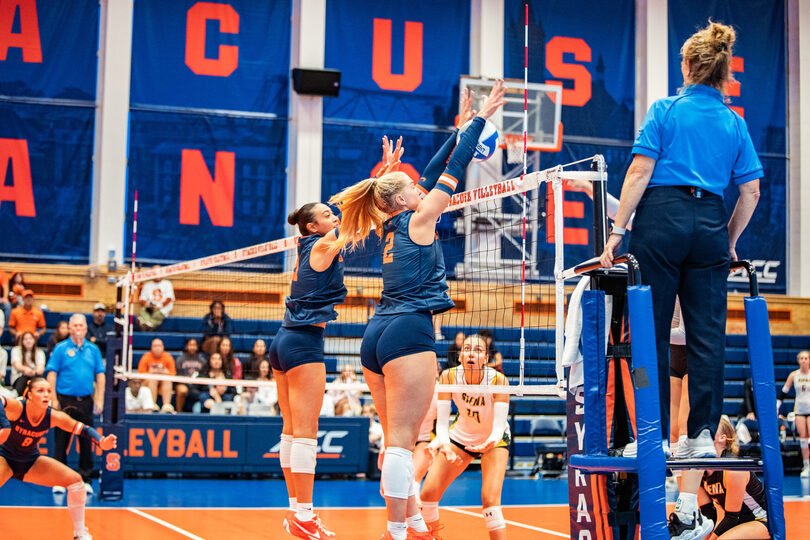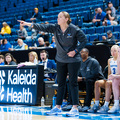Syracuse volleyball’s block improvement crucial toward conference success

After a strong nonconference showing, Syracuse has been out-blocked three times in its first four Atlantic Coast Conference games. Jonathan Theodore | Contributing Photographer
Get the latest Syracuse news delivered right to your inbox. Subscribe to our sports newsletter here.
In volleyball, a middle blocker’s height often correlates with their ability to block at the net. Smaller middle blockers usually allow outside hitters to angle shots over or through their hands.
It’s similar to a taller center in basketball, who can use their height advantage to sink a hook shot over a defender. Or in football, an offensive lineman’s size can allow them to plow over a defensive lineman.
With Syracuse’s Zharia Harris-Waddy and Soana Lea’ea each standing at 6-foot-1, SU’s middle blocker duo is objectively undersized. That disadvantage especially stands out when comparing the Orange to other defensive fronts in the Atlantic Coast Conference.
Louisville — last year’s NCAA runner-up — boasts a frontline that features Cara Creese (6-foot-6) and Hannah Sherman (6-foot-3), helping it lead the ACC in total blocks (157.5) and blocks per set (3.09) in 2025. The Cardinals also get block help from 6-foot-5 outside hitter Kalyssa Blackshear.
Though Syracuse (10-4, 2-2 ACC) relied on its superior talent in the nonconference slate, establishing its block is crucial to finding success in the ACC. The Orange currently rank 15th in blocks per set (2.15) and have been out-blocked in three out of four games to start conference play.
Harris-Waddy (44 blocks) and Lea’ea (37) have been sufficient, but further establishing the block could push SU to its highest conference win total (eight) under head coach Bakeer Ganesharatnam.
“Blocking is a big part of our team defense. We know we’re smaller than a lot of the teams we’re going to play, if not all of the teams we’re going to play in conference,” Ganesharatnam said.
Now in his fourth season at Syracuse, Ganesharatnam understands his teams don’t have the most physically imposing middle blockers. Still, he’s managed to construct successful defenses.
In 2024, Syracuse struggled mightily, ranking in the bottom half of 10 key ACC statistics. However, blocking was one area where Syracuse dominated. The Orange ranked fifth in the ACC in both total blocks (293) and blocks per set (2.53). The Orange out-blocked their opponent in nine conference matches.

Katie Crews | Design Editor
At 6-foot, Sydney Moore wasn’t a prototypical ACC middle blocker, but her 94 blocks ranked second on the team. Moore’s impact last season resembles the coaching staff’s vision for this season’s block, as Ganesharatnam said they “strongly believe that blocking has a lot to do with positioning and timing,” not just height.
Following a win against Le Moyne on Aug. 31, Lea’ea echoed that philosophy.
“I think adjusting our timing — we definitely were a little bit early in the beginning of the match, but we slowed down and matched their speed. I think that helped us establish the block better,” Lea’ea said.
Syracuse easily dispatched its first five opponents of the season, with the block rarely being tested. The first time SU was truly challenged at the net came against Cornell on Sept. 6, when it was out-blocked 11-5. While the Orange escaped with a dramatic five-set victory, the Big Red exposed its key weakness.
And this weakness resurfaced one game later against Colgate. Late into the fourth set, Sydnie Waller leapt to reject Tiana Owens’ block attempt but failed to control her rejection. The ball went out of play for a crucial Raider point. Colgate went on to out-block SU 12-9 en route to a 3-1 victory.
Despite the setback, Harris-Waddy expressed confidence in the cohesion of the middle blocker group entering conference play.
“We’re all really close on and off the court, so it definitely helps in games and in practice because we help each other see new things on the court. We really take advantage of that,” Harris-Waddy said on Sept. 23.
That sentiment proved to be true in Syracuse’s ACC opener three days later. SU tallied 14 blocks in a win over Notre Dame, one of the defining victories of Ganesharatnam’s tenure. The Orange controlled the net all night, led by the duo of Harris-Waddy (six blocks) and Lea’ea (four).
The pair’s constant touches at the net allowed Syracuse to set up digs. Trailing 11-10 in the second set, SU outside hitter Skylar George dropped to her knees for an impressive dig, one of a career-high 21 in the matchup. After the ball swung around to ND’s Morgan Gaerte on the other end, Lea’ea and Tehya Maeva rose for a combo block. That complementary play is exactly what Ganesharatnam is looking for out of the defense, powering George’s career night and SU’s win.
While the victory showcased the potential of Syracuse’s block, its next game against Louisville underscored the gap between the Orange and the ACC’s elites. The Cardinals’ towering front line of Creese, Sherman and Blackshear registered nine blocks to Syracuse’s two, handing SU its first conference loss of the season.
In its most recent defeat to Virginia, Syracuse’s poor block proved to be the difference again despite having the more efficient offense. George led the team in blocks (five), as Harris-Waddy and Lea’ea struggled, combining to match that number. As conference play progresses, George’s ability to aid SU’s middle blockers at the net will be pivotal.
With 16 ACC games remaining, Syracuse’s block will need to find consistency. If it can channel its performance against Notre Dame, SU may continue to improve under Ganesharatnam.
“(The middle blockers) are a really tight group, and we learn really well from each other,” Lea’ea said.






